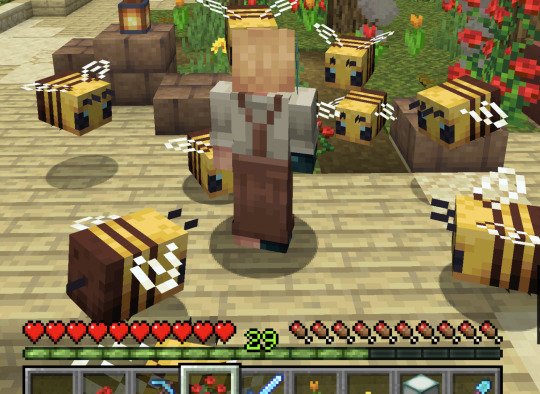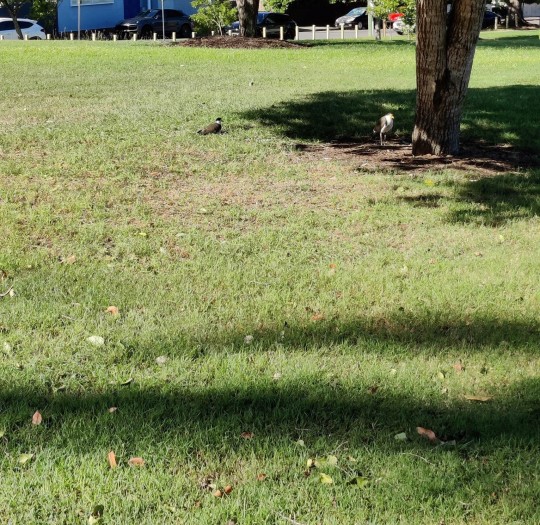#and was suddenly swarmed by every bee in the area noticing i had a flower
Explore tagged Tumblr posts
Text

SOMEbody put like 20 new beehives on my property so i had a really normal time planting flowers today
#minecraft#block game liveblogging#at one point i didnt notice another player was sleeping thru the night#until I heard the sound of 20 BEES all leaving the hive at once#and was suddenly swarmed by every bee in the area noticing i had a flower#incredible experience honestly#been working very hard renovating my entire backyard; screenshots soon!!
16 notes
·
View notes
Text
This post is wonderful and I really do believe that we should know the world we live in: the names and relationships of all these lives we could so easily not notice.
But neither a lawn nor a city is a wasteland. At least, it doesn't have to be. They will always be artificial human environments but that doesn't mean that nature can't be here too.

No part of this photo is unusual here. I could have taken a similar photo in a half dozen other places within a five minute walk, all of them surrounded by busy roads and apartment blocks.
There is grass growing here, unwatered, unfertilized and, as far as I can tell, without pesticides or herbicides. The city mows the central area but the perimeters are full of different kinds of grass going to seed.
What other plants would work here? It's a busy thoroughfare for people and (leashed) dogs. It needs to be open and able to hold up to a lot of impact, a lot of sunlight, droughts and floods.
You only have to look at the prairie to see that grass will thrive where most plants would die. It's soft and alive, it holds the soil in place, slows water, cools the yard, and gives us a place to play. It shelters other plants, like white clover and dandelions, which seem to suddenly appear from nowhere in spring.
The combination of trees and grass attracts magpies, currawongs, noisy miners, and blue-faced honeyeaters. Plovers and curlews nest on the grass. Lorikeets swarm to the trees when they flower. Ibises and crows peck through the rubbish, plentiful and clever and fat. Bush turkeys drag our mulch half way down the street, too persistent to be scared away. Kookaburras live in the gums above the school oval, so that even in the city, across a busy road and down the street, among the sound of sirens and school bells, I hear kookaburras singing.
My backyard has a lawn in similar condition, with more cover around the edges, and it is swarming with life. Wasps and bees and butterflies and ants and moths and grasshoppers and spiders. I can't step outside without disturbing some bird or lizard that has come to feed on them. A blue tongue lizard lives beside our lawn. Possums climb past our kitchen window every night. One particular family of magpies nests just outside our yard, so every year I have the pleasure of watching their chicks grow up. The current adolescent comes onto our lawn several times a day, stalking across the grass looking for food.
There are a great many problems with how we build cities and how we respond to nature in "our" places, but we can't fix those problems if we take for granted that cities are inhospitable to wildlife. Wild plants and animals can thrive here if we cut them a little slack. This really is an area where small changes can have an impact but people have to know that before they'll try.
A pair of plovers decided to nest on a nearby school oval one year. The school roped off that part of their oval, halving the amount of grass they had access to on their tiny block of land. Kids stood around the witches hats staring in confusion, irritation and wonder at these tiny, brilliant, furious birds living alongside them. And suddenly all of them knew exactly what a plover is, this one's the mum, this one's the dad, they're not hurt, plovers always live on the ground, you can't give them bread, they don't eat bread.
People come to tolerate the chaos and the inconvenience, once they see a day-old plover walking around their school like a cotton ball on stilts.
most of us have heard of the red car game. you’re on a road trip, you’re bored, you start looking for red cars to do something.
and then they’re everywhere. you notice them nearly every few minutes.
there aren’t suddenly more red cars now, of course. you were seeing them already, but you weren’t noticing. you weren’t looking.
I am noticing things.
there is a plant I notice everywhere now, a small bushy plant in suburbs, along streets, by shops on the highways. dwarf umbrella bush is what the internet tells me when I look for it’s name. I did this because I wanted to know why,
every time I ever saw it, every place,
it was always dying. always the leaves turning yellow, the branches small and scraggly. inside out - nitrogen definitely. their soil drained.
I am noticing how many of these landscaping plants are yellowing, how small and sickly they look in just a few years. I am noticing how often the grass outside the house is replaced when it once again turns brown and dry, how the type never changes and the cycle starts again. I am noticing how the unmowed, unkempt spaces on lakesides and roadsides look more alive than this. how the preserve I grew up next to was miles of “messy” unmanicured nature and the ground was covered in leaves instead of grass and there was life.
I am noticing the birds that come by the lake. there was a flash of blue wings and red chest - eastern bluebird, male, relatively common. I had never seen one before. there is a family of ducks that appear every spring; i cannot say if it’s successive generations or different ducks, but I can always look forward to ducklings. there are little brown birds with white heads whose names I do not know - are they some kind of piper? why don’t I already know?
why is it so hard to learn about my native plants (accurately, that is)? why are so many gardening sites littered with people who think a plants value is based on how pretty or useful it is to them, who think a tree shedding leaves is “messy”?
why is knowing about the world we live in so… odd? why is it a hobby and not vital knowledge? I learned about polar equations. I taught myself about mycorrhizal networks and species of insects.
(did you know there are shiny green bees? a special species of wasp pollinating figs? that white flowers bloom at night for moths? do you know? have you looked?)
I cannot look at a lawn and see life anymore. it is a wasteland, devoid of life, dying slowly itself. everywhere is grass, grass, doused in water that runs over into storm drains, soaked in fertilizer and pesticides and a hundred other poisons and sending one clear message:
this is a place of death. life is not welcome here.
I do not think I could live in a city. too loud, yes, too busy, yes, too many people, yes, but the plants would bother me. a tree allotted only a convenient square, surrounded by dead stone and metal.
a forest cleared for this, for burning asphalt streets and racing cars and shops whose bathrooms are “for paying customers only”.
this is a place of death. life is not welcome here.
and now I am noticing.
#ruin rambles#im sorry this post is so long and rambly#i tried to make it as concise as i could but like#that just isnt my skill set
1K notes
·
View notes